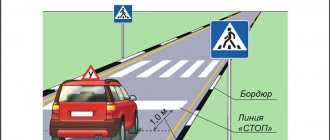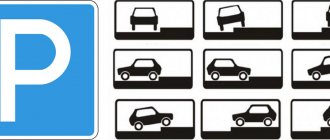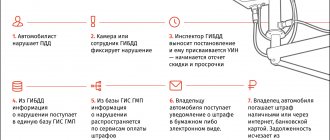Home / Vehicles
Back
Published: 05/20/2020
Reading time: 9 min
0
754
– I live in an old-style apartment building. And we often have a problem with parking - in the evenings we have to look for a place. And some cunning residents park their cars right next to the entrance to the entrance and are very in the way! Are there any legal ways to deal with them?
– Parking of personal vehicles near the entrance of a residential building is prohibited, as this may cause inconvenience to residents of the entrance due to the need to bypass the parked vehicle.
However, you can park vehicles, including personal large ones, in a temporary parking lot - for example, to load things or pick up and drop off passengers, that is, if the car ends up near the entrance for a short time.
- What legal norms are violated when parking near the entrance?
- Is it possible to determine the parking procedure in the local area at a meeting of building residents?
- Where can I complain about a parking violation?
- Measures to be taken against the violator
Parking rules in a residential area
The traffic rules have only 2 rules governing parking in a residential area. Firstly, parking with the engine running is prohibited (to prevent exhaust smoke from entering the apartments). Secondly, parking of category “C” freight vehicles is prohibited. This is all established by clause 17.3, however, in addition to this, the traffic rules have general parking rules that prohibit parking a car on the lawn and on the sidewalk unless there is an appropriate sign nearby that allows such parking.
But parking rules in a residential area are regulated not only by traffic regulations. The Russian Federation has fire safety and sanitary standards, which all citizens must also comply with.
Fire safety standards require that cars be parked so as not to block the entry into the yard for special service vehicles.
And SanPiN 2.2.1/2.1.1.1200-03 establishes the following restrictions on parking near the house:
- parking for 10 cars can be located at a distance of up to 10m from the windows/entrance to the house;
- at a distance of 11-50m from the windows/entrance to the house, parking for 15 cars can be located;
- at a distance of 51-100 m from the windows/entrance to the house, parking for 25 cars can be located;
- at a distance of 101-300 meters from the windows/entrance to the house, parking for 35 cars can be located;
- At a distance of more than 300m from the windows/entrance to the house, parking for 50 cars can be located.
Unofficial penalties for parking on the sidewalk
We have already talked enough about what official punishment may be in the form of administrative liability for parking or stopping on the sidewalk. However, not a word has yet been mentioned about the revenge of citizens, who sometimes commit lynching. Moreover, the results of such lynching can be much more serious than a fine of several thousand rubles. This can be as simple as a note, with insults, lectures and curses, or even damage to property or a vehicle. Cars are doused with paint and even set on fire.
That is why the driver should think 10 times about whether it is worth breaking the rules for parking on the sidewalk, especially if the car will interfere with someone. After all, both official fines and informal measures of reaction to such an offense are possible here.
Possible fines for illegal parking
Fines for illegal parking can be completely different, as they depend on the type of offense:
- parking on the sidewalk - 1000 rub. (in Moscow and St. Petersburg - 3000 rub.);
- creating obstacles to the movement of other vehicles - 2000 rubles (in Moscow and St. Petersburg - 3000 rubles);
- creating obstacles for a fire truck or ambulance - 500-2000 rubles. (if people died or were injured because of the obstacle, then you can also receive criminal punishment);
- parking on the lawn - up to 5000 rub. depending on the region (the fine is set by the regional Code of Administrative Offences);
- parking near garbage containers - up to 5000 rubles. depending on the region (the fine is set by the regional Code of Administrative Offences);
- creation of an illegal parking space with fences – RUR 5,000.
Tow truck payment
A fine is not the only thing that awaits an illegally parked driver. If a parked car interferes with vehicles or pedestrians, traffic police officers can send it to the impound lot. For the evacuation itself and for each day the vehicle is kept in the parking lot, the driver will have to pay a fairly large amount. More details about the rules and cost of evacuation, as well as impound parking tariffs, can be found in a separate article “Fine for evacuation of a car.”
What law governs the relationship between the parties to the contract?
The legislation regulating the resulting relationship between the parties to the contract does not provide any direct instructions that would explain the actions of the truck driver in the event that he cannot drive up to the loading and unloading area due to lack of opportunity.
Until the spring of 2021, all drivers working in Russia were inclined to “General Rules for the Transportation of Goods by Road”. This law was adopted by the Ministry of Automobile Transport of the RSFSR on July 30, 1971. Paragraph 5 of Section 5, entitled “Rules for loading and unloading cargo,” indicates that the shipper, as well as the consignee, must have at their disposal a special site, as well as access roads to it, which must be in proper condition at all times of the year . Adequate lighting must be provided for unobstructed passage as well as maneuvering. But by order of the Ministry of Transport of the Russian Federation dated March 23, 2018 No. 113 OPPGAT, the law was canceled.
In any case, all the above standards from the law do not contradict other rights. That is, the obligations of the consignee and the consignor to maintain the access road and the area for loading and unloading cargo in good condition must be fulfilled. This requirement is consistent with Article 10 of the Civil Code of the Russian Federation, which states the presumption of good faith of the parties to civil legal relations.
Fight against violators
The traffic police do not patrol the yards, so the problem with parking violators will not be solved by itself. Of course, residents themselves can take illegal measures (scratch the body, damage the tires, and so on), unfortunately, quite often this is exactly what happens. But these methods can lead to an even greater aggravation of the conflict, and if the pest is caught, then to problems with the law.
It is much more effective to deal with a violator within the framework of the law. To do this, citizens have 4 ways:
- Call the traffic police.
- Submitting a written application.
- Filing a complaint via the Internet.
- Filing a complaint through the application.
The simplest method of punishment is to call the traffic police directly to your yard. Another advantage of this method is that the violator will not only be fined, but also have the car towed. But this method also has a rather significant disadvantage - you will have to wait quite a long time for the traffic police officers; perhaps during this time the offender will have time to remove his car. You can call inspectors by calling the general number 102 or by calling the number of the duty station in your area.
A written complaint is submitted to the traffic police department. It is drawn up in free form, but must have evidence - photographs, which must clearly depict the violation itself and clearly show state registration numbers.
A more convenient option for filing a complaint is using the Internet. You can complain about a violator both through the official website of the traffic police and through special applications for smartphones: “Moscow Assistant” - for residents of the capital, Spot - for residents of the regions. Any of these methods speeds up the process of filing a complaint and relieves the citizen of the need to visit traffic police departments. But filing an online complaint should also not be groundless: it must be accompanied by photographs or videos that prove the fact of the violation and clearly display the vehicle’s license plate number.
Where can I complain about a parking violation?
You can influence a car owner who parks his car near the entrance using administrative measures:
- contact the administration of a municipality or subject of the federation to a special unit that deals with illegal parking and its elimination;
- through the official website of the State Road Safety Inspectorate or a special application, send information that there is a violation of traffic rules in the form of improper parking;
- to the fire inspectorate if such parking may pose a threat to the fire safety of the population of the apartment building.
Statements should be supported by mandatory photo or video evidence, as this will allow you to confirm the complaint and not be punished for falsely reporting an offense.
If violations are recorded in one block, which includes several apartment buildings, you can contact the administration of the city or municipality or entity with a collective statement from the residents of such a block about the need to install “Residential Zone” signs in order to obtain the right to punish negligent residents using the measures of the Code on administrative offenses under Article 12.28 on punishment for violating the Traffic Rules established for a residential area.
How to find the owner of an abandoned car and remove such a car from the yard
Demolition of parking barriers in the yard
Another problem that can be caused by unscrupulous neighbors is the installation of illegal parking barriers. Brazen violators install various posts, chains, and fences in the yard, thereby “reserving” a parking space. Such actions are also illegal.
There are several ways to combat this:
- Get rid of barriers yourself. If they are installed on public property illegally, then any resident has every right to dismantle them themselves. At the same time, it is important not to damage the road surface yourself, so as not to later be guilty of damaging public property. It is also worth thinking about possible personal problems with the parking space invader.
- Contact the local police officer. If a car is parked in a legally created parking space, and the problem is only a fence that prevents other residents from using the parking lot, then the traffic police will be powerless. In this case, citizens can call the local police officer or write a statement. It will be his responsibility to stop the violation and punish the culprit.
- Contact the Criminal Code. Management companies are also authorized to demolish illegal structures, and many companies will do this much faster than the police. However, everything depends on the company itself: managers of prestigious residential complexes quickly deal with violators, and ordinary housing and communal services may require the preparation of a collective complaint, delaying the process in the hope that the problem will be solved by itself. Another drawback of this method: the Criminal Code cannot punish the violator; its powers only include getting rid of the illegal fence.
- Contact the city administration. The last method is the longest; It is worth using it only if other methods have not brought any results. The city administration will consider the complaint for a month. As a result, she may oblige the Criminal Code to demolish the fence, and instruct the police to impose a fine on the violator. In this case, both the Criminal Code and the district police officer will definitely stop being inactive.
Fire regulations are valid from 01/01/2021 to post. No. 1479
71. Owners of land plots ensure proper technical maintenance (at any time of the year) of roads, driveways and entrances to buildings, structures, structures and external installations, open warehouses, external fire escapes and fire hydrants, reservoirs, natural and artificial reservoirs that are sources of external fire-fighting water supply.
It is prohibited to use platforms for firefighting equipment, including turning areas, intended for its installation, including for water intake, supply of extinguishing agents, and access for firefighters to the protection site, for parking vehicles on the territory of populated areas, enterprises and organizations.
It is not allowed to block passages for fire equipment with products and objects, planting large trees that exclude or limit the passage of fire equipment, the access of firefighters to the floors of buildings, structures, or reduce the size of passages and entrances established by fire safety requirements.
The fire protection system in the event of a fire must ensure automatic unlocking and (or) opening of barriers, gates, fences and other technical means installed on driveways and entrances, as well as keeping them in the open position to ensure unhindered passage of fire equipment. Manual opening is allowed when organizing round-the-clock personnel duty directly at the installation site of barriers, gates, fencing and other technical means on driveways or remotely when establishing video and audio communication with the installation site.
At the entrance to the territory of construction sites, open flat parking lots and garages, as well as to the territory of gardening or horticulture, diagrams are posted indicating the entrances, entrances, fire passages and sources of fire-fighting water supply.
Individuals are prohibited from interfering with the work of fire departments, including on the route of fire departments to the site of a fire.
72. When carrying out repair (construction) work related to the closure of roads or passages, the head of the organization carrying out the repair (construction) immediately submits to the fire department the relevant information about the timing of these works and ensures the installation of signs indicating the direction of the detour, or arranges crossings through sections of roads or passages under repair.
74. At protection sites bordering forest areas, as well as located in areas with peat soils, it is planned to create protective fire-fighting mineralized strips with a width of at least 1.5 meters, fire-fighting distances, removal (collection) in the summer of dry vegetation, shoots, shrubs and implementation of other measures to prevent the spread of fire during natural fires. Fire-prevention mineralized strips should not impede travel to populated areas and water sources for firefighting purposes.
It is prohibited to use fire-prevention mineralized strips and fire-prevention distances for the construction of various structures and ancillary buildings, agricultural work, storage of flammable materials, garbage, household waste, as well as waste wood, construction and other combustible materials.
393. The instructions on fire safety measures must reflect the following issues:
e) location of places for smoking, use of open fire, passage of vehicles, carrying out fire or other fire-hazardous work;
Where to park in the yard?
And at the end of the article about methods of dealing with parking violators, I would like to provide a list of permitted parking methods:
- Equipped parking in the yard. This is the most obvious and most preferred option. If free parking in the yard is available, then it is better to leave the car there, and not try to park right at the entrance to the entrance. Unfortunately, such parking is often not enough to accommodate all of the residents' vehicles.
- Paid parking for residents of the house. Some residential complexes sell not only apartments, but also separate parking spaces in the yard. Thus, part of the parking lot becomes private: the number of the car for which the space is intended is indicated on the asphalt, and at the request of the owner of the parking space, the management company itself can install legal barriers.
- Paid garages or parking lots. The main disadvantage of this method is the distance from housing. In addition, the car owner will have to pay for parking. However, this method also has an advantage: paid parking lots are guarded and under video surveillance, which means the driver does not have to worry about the safety of his property. If the parking lot is indoors, then in winter it has another advantage: the car does not have to be dug out from under the snow and warmed up.
Fine for parking on the sidewalk (on the street, at the entrance)
And now let’s turn to the Code of Administrative Violations. It is clear that this will be chapter 12. In it we find: Article 12.19. Violation of the rules of stopping or parking vehicles, part 3
3. Stopping or parking of vehicles at a pedestrian crossing and closer than 5 meters in front of it, with the exception of a forced stop and the case provided for in Part 6 of this article, or violation of the rules for stopping or parking vehicles on the sidewalk, except for the case provided for in Part 6 of this article , - entails the imposition of an administrative fine in the amount of 1000 rubles.
Well, of course, let’s look at part 6, because there is an indication of that here.
6. Violations provided for in parts 3 - 4 of this article, committed in the federal city of Moscow or St. Petersburg, entail the imposition of an administrative fine in the amount of 3,000 rubles.
Actually, it is now clear that parking or stopping on the sidewalk is a fine of 1000 rubles throughout Russia, with the exception of federal cities (Moscow and St. Petersburg). There the fine will be 3 times larger - 3,000 rubles.










